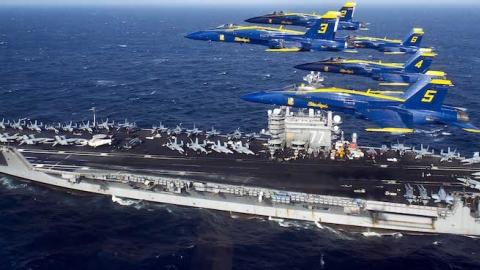The U.S. today faces a heretofore unfamiliar strategic challenge, the possibility of three linked hegemonies that span the Eurasian land mass. Russia is on the ramparts in Ukraine, Georgia, and the Middle East. Its Baltic State ambitions are not a secret. NATO’s failure to respond in a real crisis means the alliance’s end and a maturing Russian hegemony that stretches from Central Asia to the Atlantic. China actively seeks to become Asia’s hegemon. Iran’s rulers, armed with missiles of increasing range, added financial resources, and the likelihood of nuclear weapons, have their eye on dominating the strategic space between Moscow’s influence and Beijing’s.
A single hegemony on the Eurasian land mass threatens U.S. markets, our ability to keep conflict at a distance, regional stability, and democracy. At a minimum, the three hegemonies would overturn the current liberal international order. If the U.S. does not take effective action to prevent this, its run as a pre-eminent global power will end. Proximity to the oceans and seas offers the U.S. the opportunity to leverage its still-dominant seapower as the key to countering or if necessary opposing the three would-be hegemons.
Since Woodrow Wilson, the goal of American foreign policy has been to prevent regional hegemony.
Two decades after Wilson, President Roosevelt led the United States in another global conflict, against Nazi Germany and the Empire of Japan. Both Europe and Asia were—and remain— critical to our hopes for greater prosperity, security, and an increasingly democratic world. The United States and its allies destroyed both totalitarian hegemons. Finally, the United States contained the Soviet Union for almost half a century, blunting its threat to Europe, and confronting its expanding influence in Asia, Africa, the Middle East, and Latin America.
Emerging from this century of nearly continuous global conflict, the United States was the unquestioned global power. No state could challenge it economically, politically, or militarily. The U.S. destroyed the Iraqi military twice in slightly over a decade, and put a stop to ethnic cleansing in the Balkans.
New threats have ended this brief period of America’s benevolent international leadership. Three competitors are at odds with the American-led international system. The sum of their ambitions is to undermine U.S. global power.
A resurgent Russia aims to reclaim its previous glory, and capitalize on the current U.S. administration’s idea that a small America translates into a more secure world.
The European refugee crisis and potential destabilization in the European Union challenge the American alliance system in Europe – the cornerstone of American security policy since the end of World War II. America’s remaining allies show little resolve. Meager European defense budgets make matters worse.
In Asia, a rising China focuses on cultivating its economic resources and marshalling them to develop its military power. China’s island-building campaign that seeks to extend its territorial claims into international waters directly confronts the international order. As Admiral Harry Harris, commander of U.S. forces in the Pacific recently told Congress, “China has unilaterally changed the (region’s) status quo.” Beijing combines its land reclamation campaign with high-tempo presence operations, conducted by the PLAN and coast guard in contested areas of the South and East China Seas. The Chinese are also accelerating their ability to project naval power and control the seas by constructing troop transports, large surface combatants, and a second aircraft carrier.
This situation bears a resemblance to the world America faced before World War II when Nazi Germany and Imperial Japan initially overwhelmed the European powers that had refused to rearm following World War I.
But the semblance is passing. America faces not two aspiring hegemons, but three. The Middle East is the critical link between Europe and Asia. Its oil-rich states supply a large amount of the world’s energy resources, and facilitate exchange between the two hemispheres. With the Red Sea and Persian Gulf/Arabian Sea in the South, the Mediterranean to the West, and the Caspian and Black Sea to the North, the Middle East is more like an island than a contiguous land mass.
On this island Iran attempts to assert its dominance. Russia aids Iran with weapons transfers and its support of Iranian proxy Bashar al-Assad. Relieved of sanctions, the Islamic Republic has begun to receive massive financial inflows, and has actively directed some of its profits towards obtaining dual-use military technology like jet engines. Iranian Special Forces, known as the Quds Force, conduct paramilitary operations in Iraq and Syria, expanding Tehran’s influence over its neighbors.
Although America’s adversaries have worked with one another in the past, the current degree of cooperation between China, Russia, and Iran is a strategic terra incognita. Iranian oil shipped into Chinese ports generates financial resources that the Islamic Republic uses to purchase advanced weapons from Russia. Russia helps Iran fight its proxy wars while Iran supports growing Russian influence in the Eastern Mediterranean.
America’s three strategic competitors oppose the U.S. in similar ways. China, Russia, and Iran understand the lessons of the First Gulf War. Since the Cold War’s end, America’s style of warfare has been to build coalitions, amass men and resources in neighboring countries, and launch combined arms assaults that overwhelm the enemy technologically and operationally. The American-led coalition in the First Gulf War of nearly one million soldiers eviscerated an entrenched Iraqi army of over 1.5 million. However, without neighboring Saudi Arabia’s willingness, the U.S. would have been unable to conduct the operation. A naval assault would have been smaller, and Kuwait’s crowded coastline could have meant high casualties.
The First Gulf War suggested a clear strategy to counter the U.S. Deny American forces access to a region, and the U.S. loses power. Chinese, Russian, and Iranian efforts have all focused on denying America access to their respective regions. As it turns up the heat on the Baltic States, Russia is proscribing options for a rapid buildup by deploying long-range air defense and strike missiles at NATO’s borders. This is consistent with U.S. European Command commander General Philip Breedlove’s late February statement to Congress that “President Putin has sought to undermine the rules-based system of European security and attempted to maximize his power on the world stage.” China’s land reclamation campaign, increasing naval power, and anti-ship missiles aim to keep American forces at a distance from which effective combat power cannot readily be applied. Iran’s low-cost missile boats, midget subs, large numbers of ballistic and cruise missile as well as mines, and its influence at the Strait of Hormuz seek to offset American escalation. Instability in Iraq and the U.S.’s shaky relations with Pakistan further restrict staging points for an American attack.
Declining U.S. military budgets and a shrinking force combined with poor treatment of critical allies have made things worse calling into question the US’ ability to honor its commitments. The current administration’s abrogation of ballistic missile defense agreements with Poland and the Czech Republic; its prolonged interruption of defensive arms sales to Taiwan; and its failure to keep the Saudis informed about last year’s deal with Iran are examples of treating allies shabbily. As a result, the U.S. is less able to rely on adequate basing rights where they are needed both to deter and if necessary to fight.
The man or woman who takes office 10 months from now faces a new challenge to U.S. national security. It calls for changes to American strategy. The access that once allowed us to deter the Soviets has been eroded. Its resurrection in today’s Europe is unlikely. Such access is largely nonexistent in the Middle East and tenuous in East Asia.
Coalitions of allied and partner nations remain extremely important—as they have since the U.S. became a major power. U.S. ground forces will not go it alone. They rarely have. Even the 1994 operation to remove Haiti’s military junta engaged coalition partners: Poland and Argentina. The combat operation, had it been necessary, would have been staged out of the U.S, Puerto Rico and Guantanamo.
Equally reliable options are limited in Eurasia. So, while alliances and partnerships—for example, of Sunni states opposed to ISIS—are vital, they may not always be available, or dependable. If North Korea were to invade the South, there is no guarantee that Japan would allow its bases to be used for repelling the invaders or striking deep into North Korea.
Seapower possesses the advantages of geography, mobility, and—with sufficient investment—numbers and growing technological edge. It will be essential in future conflicts because it depends less on nearby bases. Logistics ships in sufficient number can keep battle groups including amphibious forces on station, present, and combat-ready largely independent of basing agreements. Maritime coalitions will likely offer more security in the future. But there is no alternative to dominant U.S. seapower today. Allies like Japan lack the industrial capacity to make up the deficit between the U.S. Navy and the expanding PLAN. Newer partners like Vietnam cannot hope to hold against a Chinese onslaught without American support. Seapower is the surest means to assure constant access to effective combat capability in the Western Pacific.
The same shift in thinking applies to the greater Middle East. Its gulfs and seas allow access that is largely independent of diplomatic agreement. Robust seapower may not be sufficient to cover our security interests in the Middle East, but its usefulness increases proportionately to the territorial holdings on which ISIS makes its claim as a caliphate. The Persian Gulf and Gulf of Oman are Iran’s southwest and southern borders. It’s a long haul from there or from the Eastern Mediterranean to Tehran but a doable one with refueling tankers based in Gulf States or carrier-launched drones of the foreseeable future that can refuel the ship’s strike aircraft.
The Cold War plan to mass land forces in defense of Europe has been voided by continental hopes that perpetual peace arrived. Even the most stalwart American partners, such as the UK, have cut military capacity and capability. But Europe is a peninsula. It is surrounded by accessible waters from St. Petersburg to Crimea. Seapower cannot stop a Russian ground invasion of the Baltics but it can snap the supply lines of an attack and give such ground forces as NATO can muster a chance to prevail. Naval vessels’ ability to project power inland can also deter Russia.
The U.S. has emerged into a new world. To the potential for nuclear warfare with a would-be peer competitor—China—that American statesmen most wished to avoid after the Cold War have been added threats from a nuclear-armed Russia, North Korea, and sooner or later, Iran. The more immediate prospect of a triple hegemony may not be an existential threat. But its outcome would cripple our markets, destroy our alliances, and endanger us where we live. All can be avoided by a change in grand strategy that continues to hold threats at a distance as it relies on the independence, accessibility, and technological superiority of seapower.



















